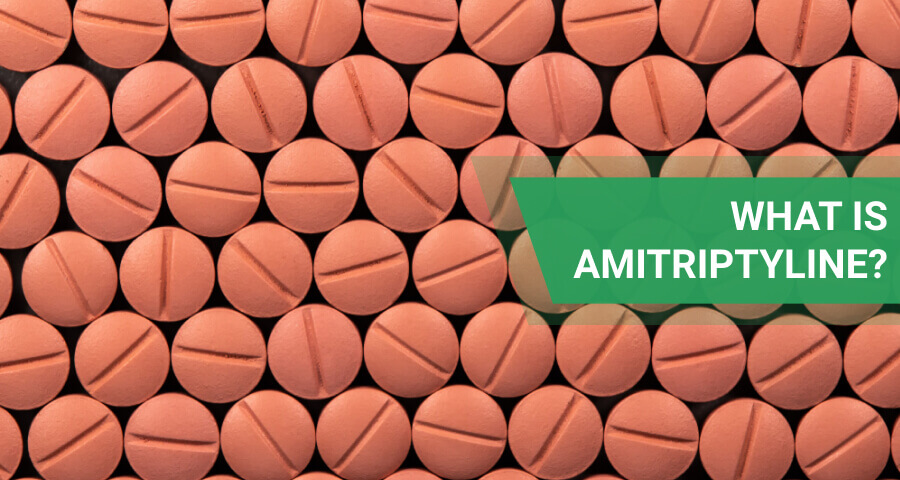
Amitriptyline, also known as Elavil, is one of the tricyclic antidepressant drugs used to treat a wide variety of mental health conditions. In the year 2018 in the United States, around ten million prescriptions of this drug are being given by doctors to treat depression. Unfortunately, while it has legitimate medical applications, this drug can also be abused, resulting in Amitriptyline addiction and other dangers to health.
Table Of Contents:
- What Is Amitriptyline?
- Amitriptyline Drug Class
- Amitriptyline Brand Names
- Amitriptyline Dosage Forms
- What Is Elavil Used For?
- Amitriptyline Abuse Statistics
- Is Elavil Addictive?
- Who is Most at Risk of Abuse?
- Symptoms Of Amitriptyline Addiction
- Dangers of Elavil Addiction
- Amitriptyline Alternatives
- Getting Help With Elavil Addiction

In this article, information about Amitriptyline uses, Amitriptyline class of drugs, dosage forms, and strengths, dangers including interaction with alcohol, risks of addiction, alternatives, support, and treatment options will be provided.
Amitriptyline abuse is not very common for a variety of reasons, including its limited availability and few people being aware of the drug. However, abuse in the usage of Elavil and other antidepressant drugs can cause tolerance which may lead to addiction over time
More About Antidepressants:
What Is Amitriptyline?
Elavil is a medication that has been approved for use in the United States since 1961. Amitriptyline hydrochloride is FDA approved for treating depression, so long as that depression is not associated with bipolar disorder. It also has numerous off-label uses, and Elavil for pain is the most common of them. Numerous studies have found Elavil to be safe, or at least as safe as other antidepressants, in most cases. With that said, Amitriptyline HCl does come with certain risks. Like all antidepressants, it can cause suicidal thoughts in the user, and the side effects of the medication are numerous. There are also interactions to consider. Due to the risks associated with the drug, it is available by prescription only, meaning that users are only meant to access it through a doctor.
Amitriptyline Drug Class
Amitriptyline class of drugs falls under tricyclic antidepressants or TCA. Currently, there are nine generics for this drug class, and the FDA approves them for use in the United States. These drugs get their name from a distinct three-ring structure, and they have two mechanisms of action. First, they increase norepinephrine and serotonin levels in the brain. Second, they block acetylcholine. The result is an increased presence of “feel-good” chemicals within the brain, allowing them to address symptoms of depression. Amitriptyline uses this exact mechanism of action to treat depression, which means the correct Amitriptyline class is a tricyclic antidepressant, which is considered relatively safe. However, this does not mean it is safe to use this drug without doctor approval. Even with careful supervision, the side effects of this drug are numerous: diarrhea, dry mouth, dizziness, and even decreased sex drive. Also, Amitriptyline causes weight gain.

Amitriptyline Brand Names
Drugs may be sold under their generic names or brand names. Aside from the brand Elavil, there are also many companies that market Amitriptyline under other names, as well as generics that are simply called Amitriptyline HCl.
Below are some available brand names in the United States:
- Elavil – most well-known amitriptyline brand name, manufactured by AstraZeneca.
- Endep – manufactured by Alphapharm (Australia), this brand is available in three dosage strengths: 10mg, 25mg, and 50mg.
- Vanatrip is also available in three dosage strengths: 10mg, 25mg, and 50mg.
Brand names may differ from one country to another. Aside from the brand names mentioned above, there are also other brand names available in other countries.
Below are some brand names available in some Asian countries:
- Welltrip
- Amitra
- Tryptomer
- Tryptanol
- Tyline
- Psycomer
There is not a problem when it comes to buying alternative brand names as long as the generic name and dosage strength are the same. However, it is important to always choose the recommended brand by the prescriber especially when the dosage form is noted to be important.
Amitriptyline Dosage Forms And Strengths
Amitriptyline dosage is available in six strengths: 10mg, 25mg, 50mg, 75mg, 100mg, and 150mg. However, doses of this drug can vary based on the reason for treatment and the patient’s individual needs. Also, this drug comes in the form of a tablet and capsule with distinctive colors depending on the strength.
Amitriptyline 10 MG
10 MG tablet is pink, round with an imprint code GG 40 on one side of the pill.
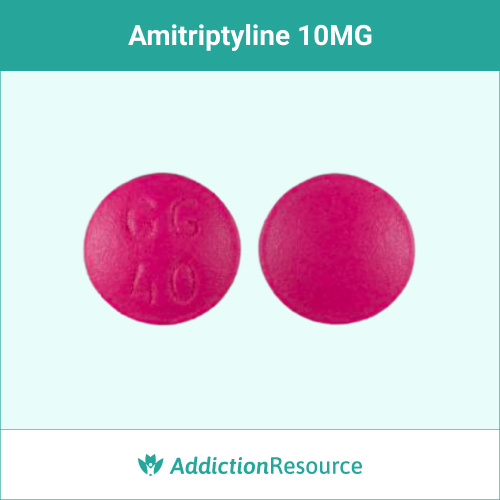
Elavil 25 MG
The 25 MG pill is round, light green with an imprint code GG 44 on one side of the tablet.
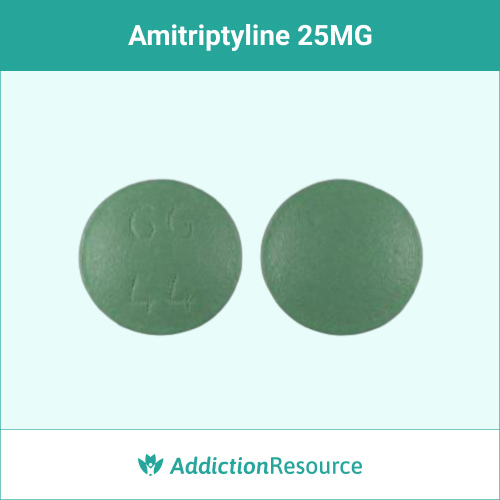
Amitriptyline 50 MG
The tablet is brown, round and an imprint GG431 is on one side of the pill.
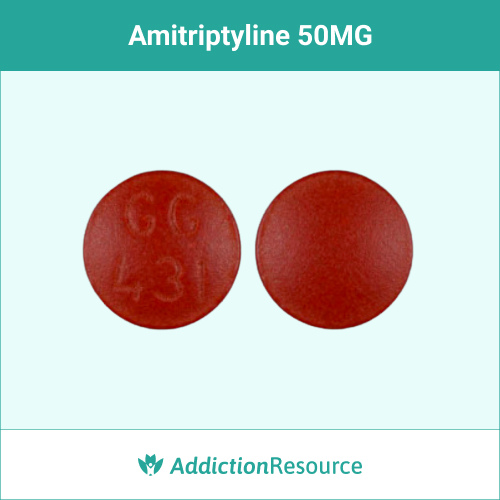
Elavil 75 MG
The pill is purple, round and an imprint GG451 is on one side of the tablet.
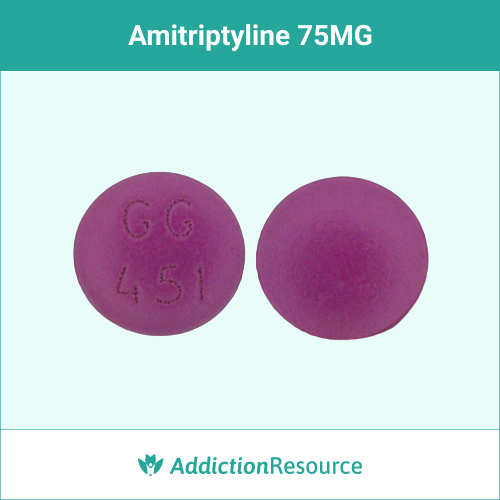
Amitriptyline 100 MG
The tablet is orange, round with an imprint GG461 on one side of the tablet.
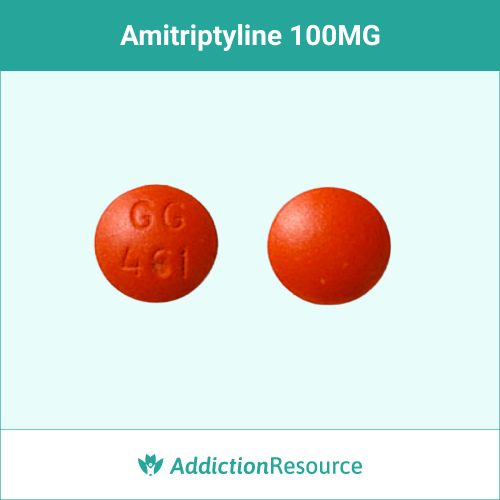
Amitriptyline 150 MG
It is a capsule-shaped, light green tablet with an imprint GG450 on one side of the pill.
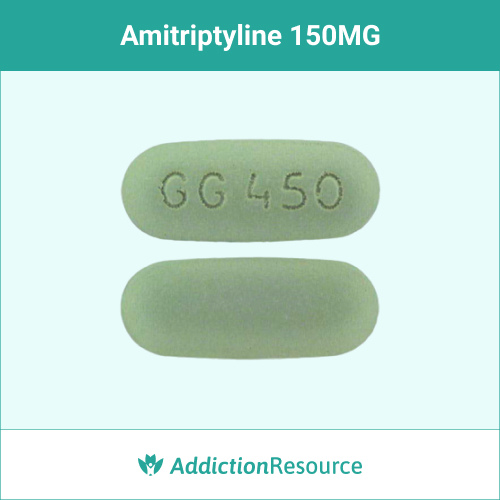
All tablets are film-coated with a specific imprint on one side and plain on the other side. Both tablets and capsules are available in bottles of 30, 100, and 1000 units. Doses of this drug should be taken around the same time each day at about 2 hours before bedtime and as instructed by a doctor. The maximum dose of Elavil is 150 mg on average. Taking more than the recommended dosage may be fatal. Therefore, in case of an overdose of this drug, emergency overdose treatment should be administered to the patient by a qualified medical professional. The safety of this drug is not approved for children under the age of 12 years.
What Is Elavil Used For?
Amitriptyline hydrochloride for depression is the main utilization of the medication that is presently endorsed for use in the United States by the Food and Drug Administration. Elavil is an antidepressant with sedation effects on the body, and as such, inhibits the uptake of norepinephrine and serotonin adrenergic neurons. Long-term use of Elavil has been believed to ease the side effects of depression. However, patients should use this antidepressant, according to the doctor’s prescription to achieve maximum benefit from the drug and minimize the adverse effects.
The Off-Label Uses Of Elavil
Amitriptyline hydrochloride can also be prescribed off-label for the treatment of several health conditions such as sleep disturbances, migraine, anxiety, and irritable bowel syndrome (IBS). Below is a chart about the off-label Amitriptyline uses:
| For sleep | Data from the Centres for Disease Control and Prevention indicates that about 35 out of 100 Americans are not getting enough sleep due to sleep disturbances. Elavil is used to treat sleep disturbances due to the resulting effect it has on histamine. The amitriptyline dosage for sleep is usually lower in contrast to the dosage prescribed to treat depression. |
| For pain | The medication is used in the treatment of neuropathic pain, which is pain from damaged nerves, which has a variety of other names. The use of this drug for pain provides relief in 25% more people than placebo. However, the long-term side effects of Elavil are also reported in about 1 in 4 more people than placebo. |
| For migraines | Although it has not been approved in the prevention of migraines, one of Amitriptyline uses is for migraine prevention and this has been proven effective in many patients. In a study, this drug is used as prophylaxis not just for migraines but also for daily headaches. |
| For anxiety | In a weekly clinical study, out of the 23 patients who completed the study, 17 had all the earmarks of being completely relieved of the condition. In this manner, the Elavil indication for the treatment of anxiety has been demonstrated to be compelling. |
| For irritable bowel syndrome (IBS) | One of Amitriptyline uses is for the treatment of irritable bowel syndrome. In a preliminary study, the medication was seen as fundamentally progressively powerful in increasing satisfaction with bowel movements. |
Nonetheless, antidepressant drugs, including Elavil, take time to work, and, therefore, patients are advised to follow the prescription even if they do not see immediate improvements. Furthermore, stopping the medication abruptly may cause withdrawal symptoms as well.
Amitriptyline Abuse Statistics
The majority of individuals taking Elavil use is as directed by their doctor. Amitriptyline abuse is not very common for a variety of reasons, including its limited availability and few people being aware of the drug. However, abuse in the usage of Elavil and other antidepressant drugs can cause tolerance which may lead to addiction over time. Individuals abuse this drug because of its side effects.
According to a study, it was reported that 25 out of 100 individuals prescribed with this drug in the United States abuse the use of the drug to achieve its desired side effects. In Sri Lanka, there is limited access to prescriptions that is why individuals who use this drug use their years-old prescription when buying in pharmacies. Because of this, there is a need to have a strict protocol when dispensing medications to patients in order to support the proper usage of medications.
Is Elavil Addictive?
When looking at addiction from a medical standpoint, Elavil is not considered to be addictive. However, many users consider themselves to have an Amitriptyline addiction. Some may find this to be physical dependence, experiencing bodily symptoms when missing a dose or taking less than normal. Others consider this a mental addiction because they feel afraid to go without their medication or as if they depend on it to live.
There is also the fact that if someone stops taking it cold turkey, they can experience withdrawal. Essentially, while the medical community does not feel all of this meets the standard of addiction, patients often feel differently, especially those who have abused the medication. If someone feels like they are dependent upon Elavil, the best thing to do is to seek treatment and support for addiction in order to save their mental and physical health.

Who is Most at Risk of Amitriptyline Abuse and Addiction?
Elavil has the potential to cause dependence on some individuals, and these individuals prescribed with antidepressant drugs who do not follow doctor’s recommendations are vulnerable to drug abuse and addiction.
Below is a piece of information about the individuals who might possibly abuse the drug and have Amitriptyline addiction:
- Those with mood disorders are more likely than the general population to turn to Amitriptyline abuse and develop an addiction. This is often because users are attempting to self-medicate and treat their underlying condition in a way that seems accessible to them. While this is never effective and actually makes their mood disorders worse, euphoria can offer a temporary feeling of reprieve.
- For someone being treated with Elavil, it is an easy leap to think that taking more might be even better than their prescribed dose, especially if they notice euphoric sensations. This can drive them to take more and more 100 mg pills and increase their dose on a regular basis, leading to Amitriptyline addiction and other dangers to their health.
- Those who are using Elavil for pain might end up abusing the drug. Experiencing chronic pain can be depressing, driving the user to attempt to self-medicate against their developing mood disorder. Depending on how severe the pain is, Amitriptyline abuse could also be a form of escape.
Countries with deficient areas of drug prescription and free accessibility of medications where no strict legislations and governance when it comes to prescription medications are also most at risk of Amitriptyline abuse. When antidepressant misuse is detected from an individual, it is important to immediately seek medical care.
Signs and Symptoms Of Amitriptyline Addiction And Abuse
Individuals doing Amitriptyline abuse may show signs and symptoms of addiction in time, especially when consumption of the drug out of the prescribed recommendation has been happening regularly. Like other antidepressants, addiction and abuse in the drug Elavil affect the physical and psychological/behavioral health of a person. In this section, signs of changes in the physical and psychological behaviors of a person addicted to the drug will be provided.
Physical Signs and Symptoms of Elavil Addiction and Abuse
Individuals who continually use and abuse antidepressant drugs may become dependent (physical dependence) on these substances which may lead to addiction. These changes may grow more as a person becomes more addicted to the drug.
Below are physical signs and symptoms that indicate Amitriptyline addiction:
- General decline in functioning
- Changes in physical appearance such as weight loss
- Difficulty of breathing
- Enlarged pupils
- Agitation and irritation
- Changes in sleep patterns
Amitriptyline abuse may lead to a potential overdose. Eventually, this can be life-threatening and may even lead to death. Emergency treatment and support must be given to anyone who is experiencing the physical signs and symptoms listed above in order for that person to be able to get not just early detections but also treatment options.

Psychological/Behavioral Signs and Symptoms of Elavil Addiction and Abuse
Aside from the physical changes caused by Amitriptyline addiction and abuse, psychological/behavioral changes might also be observed. As a person continuously uses the drug Elavil out of its recommended instructions, more and more societal consequences might be observed.
Below are some potential signs and symptoms when an individual has abused the drug Elavil:
- Losing interest in activities that a person used to enjoy
- Problems or difficulties arising in relationship with other people
- Difficulty in accomplishing tasks whether be it school, at home, or at work
- A sense of need to procure the substance
- Going to different doctors to get a lot of prescriptions
- Lack of self-care or hygiene
- Presence of criminal or aberrant behaviors
- Constantly increasing doses to get the desired effect
- Lying about symptoms in order to get prescriptions
- Request for early Elavil refills
Abusing the drug Elavil is dangerous to the health, and a person using it will conceal the behaviors listed above from a prescriber. Additionally, emotional changes such as mood swings may also occur in a person who is addicted or abusing it. A physician or a close relative must be aware of the signs and symptoms above in order to detect early prescription misuse.
Dangers of Elavil Misuse And Addiction
When using antidepressant drugs, it is important to note their benefits and dangers to the patient’s health. Talking about benefits, correct usage of the prescription drug will allow a patient to fully optimize the medical use of the drug. However, dangers will occur when abuse of the drug Elavil happens. A Neuroleptic malignant syndrome is a dangerous case that might happen during Amitriptyline abuse.
Other potential negative consequences of abusing Elavil include:
- Seizures
- Confusion
- Psychosis
- Increased depression
- An inability to feel normal when not taking the medication
- Damage to the organs, especially the kidneys and liver
The consequences above may change depending on how Elavil is taken including when it is taken with alcohol and other drugs that might interact with it. Additionally, Amitriptyline abuse may cause potential overdose and this can be dangerous as it can lead to death. If a person is experiencing unusual side effects of the drug, it is important to immediately seek medical care.
Amitriptyline abuse may lead to a potential overdose. Eventually, this can be life-threatening and may even lead to death.
Mixing Amitriptyline With Alcohol
Mixing Elavil or any antidepressant drugs with alcohol is considered a moderate food-drug interaction. A food-drug interaction may change how the drug Elavil works. When taken together, the sedative effects of the former increase. When this happens, intense drowsiness, fatigue, and lack of coordination may be experienced. Additionally, mixing these two substances together may actually be fatal. For this reason, a patient must consider sharing his or her alcohol usage with the prescriber in order to avoid interactions as this may alter the mental alertness of the patient. Aside from the alcohol, before using this drug, a patient must inform his or her prescriber about the other medications being taken in order to adjust the doses as these medications may possibly cause interactions as well.
Amitriptyline Alternatives
Amitriptyline HCl is not the only option people have when it comes to antidepressant drugs. In fact, there are several dozen medications to choose from. If someone is struggling with Elavil but still needs treatment, alternatives could help. Below are some alternatives for for this drug:
Nortriptyline vs Amitriptyline
Nortriptyline might work as an alternative for someone who is unhappy with Elavil but needs medication as similar to it as possible. It is important to note that the drug of choice for depression is Amitriptyline, when mild sedation effects are desired. However, a prescriber may consider the drug Nortriptyline when a patient requires lesser sedating effects.
When it comes to the side effects, Nortriptyline has the following side effects which the Amitriptyline does not have:
- Ringing in the ears
- Decreased sex drive
- Breast swelling
The side effects mentioned above may be annoying but manageable compared to the side effects of the Elavil. When it comes to interaction, both of these drugs interact with alcohol. Additionally, the latter is available in capsule and liquid forms compared to the former, which is only available in capsule form.

Amitriptyline vs. Trazodone
Trazodone is a serotonin modulator, which means it treats depression in a radically different way from Elavil. It is less likely to cause side effects, which means that if negative symptoms of use are driving someone away from medicine, it could be a solid alternative. However, it has roughly equal abuse potential, so if someone is looking to switch due to misuse, it may not offer a solution.
Other Alternatives
In addition to the drugs above, there are a wide variety of medications and herbal supplements that can treat the same conditions as Elavil. However, patients should never stop taking the medicine or switch to something new on their own. Suddenly stopping an antidepressant can be incredibly dangerous and should only be done under the guidance of a medical professional.
Getting Help With Elavil Addiction
Elavil is not a drug widely known for being abused, but when someone misuses it, the results can be deadly. With the right help and support, it is possible to get clean and still find options for depression treatment. Knowing that abusing this drug is dangerous, anyone who is doing so should seek out help getting clean. Experts involved with addiction treatment understand why patients are drawn to addiction and know how to help them turn their lives around. By working with the right treatment for Amitriptyline addiction, it is possible to live a clean life.
Drug rehab facilities know how to manage antidepressant misuse and addiction. With so many rehab centers available in the US, the most difficult step is just reaching out to find the right one. The staff in such facilities can design a customized treatment for substance abuse to make the process of recovery easier and more effective.
Hope Without Commitment
Find the best treatment options. Call our free and confidential helpline
Most private insurances accepted
Find Drug Rehabilitation Centers Near You Anywhere In the US
Addiction Resource team has compiled an extensive list of the top drug rehabilitation facilities around the country. Use our locator tool to find the best centers near you.
Page Sources
- Abbar, M., Carlander, B., & Castelnau, D. (1996). Tricyclics and malignant syndrome. European psychiatry, 11(4), 212-213.
- Allen, D., & Lader, M. H. (1989). Interactions of alcohol with amitriptyline, fluoxetine and placebo in normal subjects. International clinical psychopharmacology.
- Cohen, M. J., Hanbury, R., & Stimmel, B. (1978). Abuse of amitriptyline. JAMA, 240(13), 1372-1373.
- Couch, J. R., & Amitriptyline Versus Placebo Study Group. (2011). Amitriptyline in the prophylactic treatment of migraine and chronic daily headache. Headache: The Journal of Head and Face Pain, 51(1), 33-51.
- Moore, R. A., Derry, S., Aldington, D., Cole, P., & Wiffen, P. J. (2015). Amitriptyline for neuropathic pain in adults. Cochrane Database of Systematic Reviews, (7).
- O’Sullivan, C., & Froyman, C. (2018). Nortriptyline safer than amitriptyline?. Canadian Family Physician, 64(9), 634-636.
- Quello, S. B., Brady, K. T., & Sonne, S. C. (2005). Mood disorders and substance use disorder: a complex comorbidity. Science & practice perspectives, 3(1), 13.
- Rajagopalan, M., Kurian, G., & John, J. (1998). Symptom relief with amitriptyline in the irritable bowel syndrome. Journal of gastroenterology and hepatology, 13(7), 738-741.
- Thour, A., & Marwaha, R. (2020). Amitriptyline. StatPearls Publishing.
- Umaharan, T., Sivayokan, S., & Sivansuthan, S. (2021). Amitriptyline Dependence and Its Associations: A Case Report and Literature Review. Case Reports in Psychiatry, 2021.
- Zaltzman, D. A. (1976). Amitriptyline hydrochloride in the treatment of anxiety and insomnia and as a tranquilizer. Neurologia, neurocirugia, psiquiatria, 17(3), 165-169.


 Reviewed by:
Reviewed by:  Written by:
Written by: 

 FindTreatment.gov
FindTreatment.gov